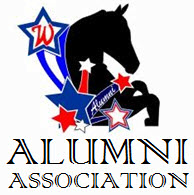History Highlights of the Westernaires at National Western Stock Show & Rodeo, part 1 of 3
National Western Stock Show holds a special place in the hearts of Westernaire riders.
The first National Western Stock Show occurred in January of 1906. While some may claim to be bigger or better, none can match the excitement and excellence of the National Western Stock Show and Rodeo, held every January in Denver, Colorado. Cowboys, ranchers, wholesalers, breeders, and exhibitors from all over North America flock to Denver just after the holiday season for two weeks of wheeling and dealing, competing and celebrating. From beginning to end, it is the most riveting show in town.
One of the major events on the Westernaires yearly calendar is the National Western Stock Show, where our riders perform both the Grand Entry and a feature drill in each PRCA rodeo performance for the duration of the show. Excused from local schools for the run of the rodeo, Westernaires riders study between performances to maintain good grades. Ask any Westernaires Varsity Red Team alumnus and they'll tell you that it's an unforgettable experience to participate in the headlining act of this remarkable show.
National Western Stock Show is also a graduation for some of the Westernaires Varsity Big Red Team riders. Those who have graduated from local high schools the past June have the option of remaining in the organization through this amazing event. The final Ride of the Colors and Pass in Review at the closing of National Western marks the end of their career as Varsity riders. It is an emotional farewell.
“In 40 years as a Master-of-Ceremonies serving major events in this country, Canada and Australia, I have never seen a mounted drill that can equal that of the Westernaires’ “Big Red” group. The riding of these young people offers the ultimate in speed, precision and color. Judging from the reception this group always receives, my opinion is shared by tens of thousands. It is a pleasure to recommend this group for any occasion where a riding drill may be used.”
History Highlights of the Westernaires at National Western Stock Show & Rodeo
1952: Westernaires make their first appearance at NWSS
In 1952, Westernaires was often referred to as the "Paul Gregg Pony Club". It was right about then that Elmer E. Wyland, Founder of Westernaires, was settling on the new name of "Westernaires".
1952 was also the inaugural year for the new Denver Coliseum building, where the National Western Stock Show's rodeo is held.
Westernaires split at the rail during their first ever National Western Stock Show performance, in January of 1952
Westernaires perform drill maneuvers and an exhibition of cloverleaf patterns around barrels in the Young Folks Show at the 1952 National Western Stock Show and Rodeo
Carol Ann Akin warms up her horse in the Stockyard Stadium
Warm-up before or cool-down after the 1952 debut appearance of Westernaires at National Western Stock Show
Westernaires Founder and Director, Elmer Wyland (right), directs the troops through warm-up maneuvers in the Stockyard Stadium prior to their performance in the 1952 National Western Stock Show.
The program cover for the 1952 National Western Stock Show and Rodeo
After a successful 1952 performance, the Westernaires were invited back for repeated performances at the National Western Stock Show in 1953. In 1954, Westernaires were asked to become a headline act; they accepted so with great pleasure.
1955: The Westernaires receive a commission for a special act from the National Western Stock Show
By 1955, the Westernaires were making numerous appearances in National Western's rodeos (seven in 1955). After a very successful four years of performing at their prestigious events, National Western's new General Manager, Willard Simms, asked the Westernaires to come up with a special act to commemorate the National Western's upcoming 50th Anniversary. Ever the showman, Westernaires Director Elmer Wyland was up to the task.
Wyland's idea was to create an act that paid homage to the era in which National Western Stock Show was started (1906), while also giving a nod to the future. He put out a call to his vast network of friends, colleagues, and acquaintances that the Westernaires was looking for sidesaddles for a new act in development.
An unexpected outcome came from his request for sidesaddles. Not only did people find their grandmothers' dusty old sidesaddles in their barns, but they also found antique McClellan Cavalry saddles, old bits, rare tack, and historic driving harnesses too. Mr. Wyland received a deluge of antique equipment -- some of it from the far reaches of the globe. With this, he formed an outfitted a complete Westernaires Cavalry team, and also created an award-winning Westernaires Museum of Riding and Driving History.
The Westernaires put in seven appearances at the 1955 National Western Stock Show in Denver. Here, the 30-rider precision drill team executes the "Gear Wheels" maneuver.
Dick Hammond, Westernaires roman rider, was featured in the Westernaires acts at the 1955 National Western Stock Show.
“It was to feature 50 years of progress in “The West’s most useful livestock event.” Gold decorations were ordered, along with gold trimmed ribbons and gold colored badges. I asked E. E. “Elmer” Wyland if he could put together a troupe of his Westernaire girls riding side saddle in the arena shows. He jumped at the opportunity, somehow acquiring [16] side saddles, developing authentic riding dresses of 1906 fashion for a group of [16] teenage girls he trained for a side saddle drill!”
“There is no drill group, at least in my experience stemming over these 40 years or more, that has the speed, the precision, the color and all that the Westernaires have. I marvel at it every time I present it, and I’ve been presenting Westernaires for about 28 years.”

